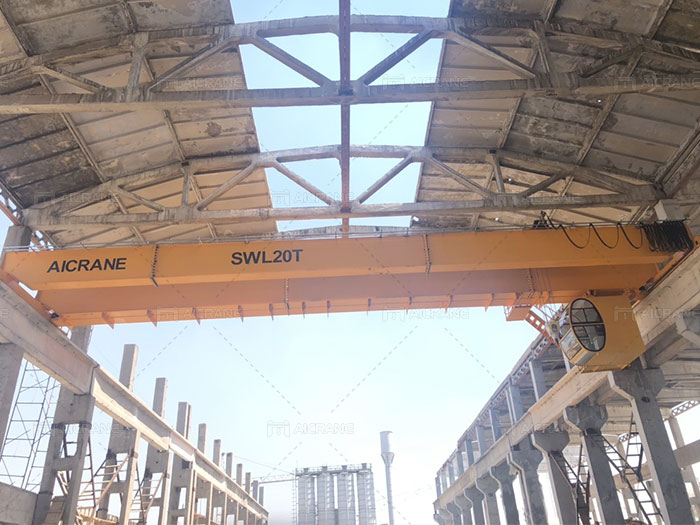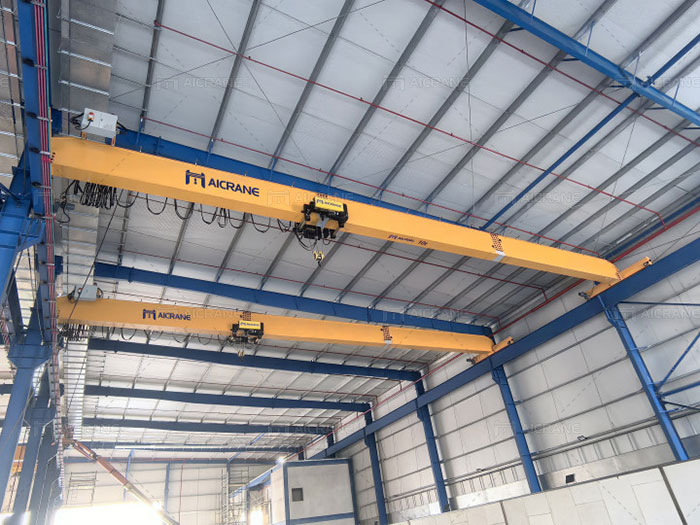Bridge cranes play an essential role in various industries, from manufacturing and construction to warehouses and distribution centers. When it comes to selecting the right crane for specific lifting tasks, one of the most critical factors to consider is load capacity. Load capacity determines the maximum weight a crane can safely lift, and it directly influences the crane’s design, performance, and safety features. In this article, we’ll explore the key load capacity considerations for single and double girder bridge cranes, comparing their capabilities, advantages, and applications.

Understanding Single and Double Girder Bridge Cranes
Before delving into the differences in load capacity, it’s important to understand the fundamental design distinctions between single and double girder bridge crane.
-
Single Girder Bridge Cranes: These cranes feature a single horizontal beam (the girder) that supports the trolley and hoist. The girder is typically made of steel and is the main structure that carries the load. Single girder cranes are commonly used for light to medium-duty lifting applications, offering an economical solution for environments where lower capacities and lighter loads are required.
-
Double Girder Bridge Cranes: As the name suggests, double girder cranes consist of two parallel beams that support the hoist and trolley. These cranes are designed to handle heavier loads and offer greater lifting heights and spans. Double girder cranes are commonly used in heavy-duty applications, where high lifting capacities are needed, such as in manufacturing plants, construction sites, and steel mills.
Key Load Capacity Considerations
When choosing between single and double girder bridge cranes, several factors affect load capacity. Let’s examine the main considerations that influence the capacity of each crane type:
1. Design and Structural Strength
-
Single Girder Cranes: The structural strength of a single girder bridge crane limits its load capacity. Since there is only one girder to support the load, the overall strength of the crane is inherently lower compared to a double girder design. A single girder crane’s load capacity typically ranges from 1 ton to 20 tons, although higher capacities can be achieved with customized designs. However, the crane’s lifting height and span are also limited by this design.
-
Double Girder Cranes: Double girder cranes can support much higher loads due to the presence of two beams that share the load. The two girders distribute the weight evenly, allowing the crane to lift much heavier loads. Double girder cranes can handle capacities of up to 100 tons or more, making them the preferred choice for industries requiring heavy lifting, such as steel processing, power generation, and large construction projects.

2. Load Distribution and Safety
In any crane system, ensuring that the load is evenly distributed is crucial for safety and performance. Uneven load distribution can lead to excessive wear on the crane’s components and may even cause failure in extreme cases.
-
Single Girder Cranes: The load distribution in single girder cranes can be less efficient because the single girder is responsible for all the weight. As a result, these cranes are more prone to stress on individual parts such as the girder, hoist, and trolley, which can lead to potential mechanical failures if not properly maintained.
-
Double Girder Cranes: Double girder cranes offer superior load distribution because the weight is shared between the two girders. This design reduces the strain on individual components, leading to greater stability and safety during lifting operations. As a result, double girder cranes are better equipped to handle heavy and uneven loads without compromising safety.
3. Lifting Heights and Spans
Lifting height and span refer to the distance the crane can lift an object and the horizontal distance it can move the load. These two factors are critical for applications that require extensive reach or the ability to lift heavy objects to great heights.
-
Single Girder Cranes: Single girder cranes have limited lifting heights and spans due to the constraints of their design. The hoist and trolley are often positioned lower on the crane, which can limit the height the crane can lift loads. Additionally, the span (distance between the two supports of the crane) is typically shorter, which may restrict the crane’s ability to move heavy loads over long distances.
-
Double Girder Cranes: Double girder cranes offer greater flexibility in lifting heights and spans. With two girders, the hoist can be positioned higher, allowing for increased lifting height. The extended span between the two girders also enables these cranes to move heavier loads over longer distances. This makes double girder cranes ideal for large facilities or areas with wide-ranging material handling needs.
4. Work Duty and Frequency of Use
Work duty refers to the frequency of crane operation and the intensity of lifting tasks. Cranes that are used for frequent, heavy-duty operations require higher load capacities and stronger structural integrity to ensure they can withstand the stress of constant use.
-
Single Girder Cranes: These cranes are designed for light to medium-duty work, making them suitable for tasks that don’t require high lifting capacities or frequent use. For example, they are ideal for moving materials in warehouses or lifting smaller components in factories. The work duty for single girder cranes is typically classified as A3 to A5 (light to moderate), indicating that they are built for occasional to frequent lifting but not for constant, heavy-duty work.
-
Double Girder Cranes: Double girder cranes are designed to handle heavy-duty tasks and can endure continuous, intense operations. They are often used in environments where high load capacities are required, such as in automotive plants, steel mills, or shipyards. The work duty classification for a heavy duty overhead crane is typically A5 to A8 (frequent to continuous), meaning they are built to withstand heavy lifting throughout the workday without compromising performance or safety.
5. Customization and Adaptability
Both single and double girder cranes can be customized to meet the specific needs of an operation. However, double girder cranes offer more flexibility in terms of adapting to high load capacities and specialized lifting conditions.
-
Single Girder Cranes: While single girder cranes are versatile in lighter applications, their ability to be customized for very high loads is limited. Customization typically involves adjusting the size and materials of the single girder to accommodate slightly higher capacities, but there are inherent limits to what a single girder crane can achieve.
-
Double Girder Cranes: Double girder cranes offer more robust customization options. These cranes can be fitted with powerful hoists, advanced control systems, and other features that enable them to handle very heavy loads. Moreover, they can be designed to work in extreme environments, such as in high temperatures or corrosive atmospheres, making them suitable for specialized lifting tasks in diverse industries.
Conclusion: Which Crane Should You Choose?
In conclusion, the decision between a single girder and a double girder bridge crane largely depends on the specific load capacity requirements of your operation. Single girder cranes are ideal for light to medium-duty lifting tasks, offering an affordable and efficient solution for industries with less demanding needs. However, for heavy-duty applications that require high lifting capacities, long spans, and frequent operation, double girder cranes provide the necessary strength, safety, and reliability.
When choosing the right bridge crane for sale for your business, it’s essential to carefully consider the lifting capacity, load distribution, work duty, and customization options. Both crane types have their unique advantages, but understanding your specific needs will help ensure that you select the optimal solution for your lifting tasks, improving productivity, safety, and overall efficiency in your operations.